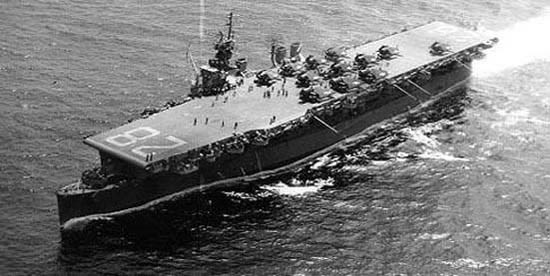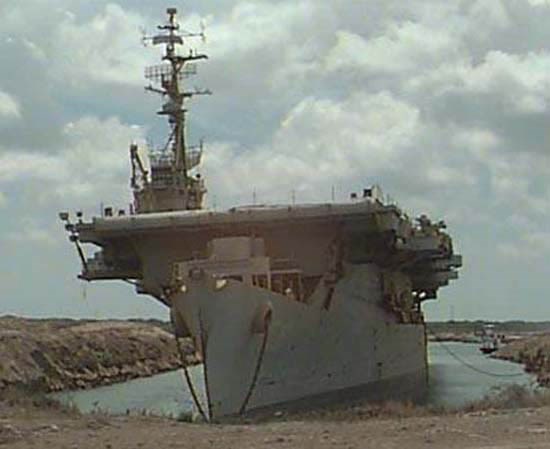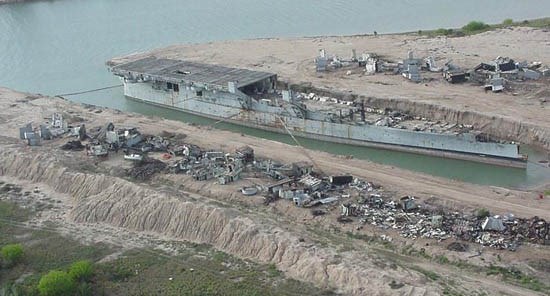
US Navy Photo
U.S.S. Cabot (CVL-28)
Brownsville, TX
Designated an NHL: June 21, 1990
Designation withdrawn: August 7, 2001
The US entered World War II with seven aircraft carriers but by early 1942 only one remained operational. In June of that year, in order to meet the Navy's pressing demand for carriers while the Essex class was under construction, President Roosevelt ordered the conversion of nine Cleveland-class light cruiser hulls to the Independence-class light aircraft carrier. Nine of these carriers were completed by the end of 1943. The U.S.S. Cabot (CVL-28) was the only one of the nine to survive for nearly five decades.
Cabot was built by the New York Shipbuilding Corporation and entered service in January 1944. Throughout 1944 and 1945 she participated in raids on Truk, the Marshalls, Palau, Hollandia, and the Marianas, and in the invasions of the Philippines, Leyte, Iwo Jima, Okinawa, and Wake Island. Dozens of enemy ships were sunk by the Cabot and 252 planes were downed. She was also selected as the carrier to host war correspondent Ernie Pyle when he covered carrier operations late in the war. It was Pyle who gave the vessel the nickname "Iron Woman" after it underwent multiple attacks without ever stopping for repairs. Cabot served in nearly every major naval engagement in the Pacific for which she earned nine battle stars and the Presidential Unit Citation. Decommissioned in 1947, she was transferred to Spain in 1967 and renamed Dedalo as part of a lease program. Purchased by the Spanish government in 1973, she served in their navy until 1989.

ECOSAT Photo
Cabot was acquired from Spain by the New Orleans-based Cabot-Dedalo Museum Foundation. The vessel was designated a National Historic Landmark on June 29, 1990, but the museum foundation folded when it was unable to secure sufficient funds for restoration. The carrier remained moored in New Orleans, deteriorating and accumulating large fees for dock space and environmental clean-up. Considered a danger to shipping traffic in the Port of New Orleans, she was moved to Texas in 1997. In 1998 the vessel was seized by US Marshals and auctioned off in 1999 to pay the accumulated debts. While the vessel was named a national treasure by the National Trust for Historic Preservation shortly before the auction, efforts by preservation groups failed to raise sufficient funds to purchase Cabot. The vessel was purchased by Sabe Marine Salvage; subsequently, the Environmental Protection Agency barred the company from taking the ship overseas for salvage because of the presence of hazardous materials.
Scrapping of Cabot began in November 2000 at the Port of Brownsville, Texas, in a special scrapping facility built by Maruti Steel, Inc. Much of the flight deck was first dismantled and portions of the deck including the island tower, antennas, and gun mounts were sold to aircraft carrier museums. Some miscellaneous artifacts were removed and deposited with museums or the Curator Branch of the Naval Historical Center, US Navy.

ECOSAT Photo
The Landmark designation of Cabot was withdrawn on August 7, 2001, as the qualities that originally led to its designation had been destroyed. The fate of the vessel does illustrate an important point about the National Historic Landmark designation. The designation of a property as National Historic Landmark does not restrict the manner in which the property may be used, altered, or disposed of by a private owner.
Last updated: August 29, 2018
